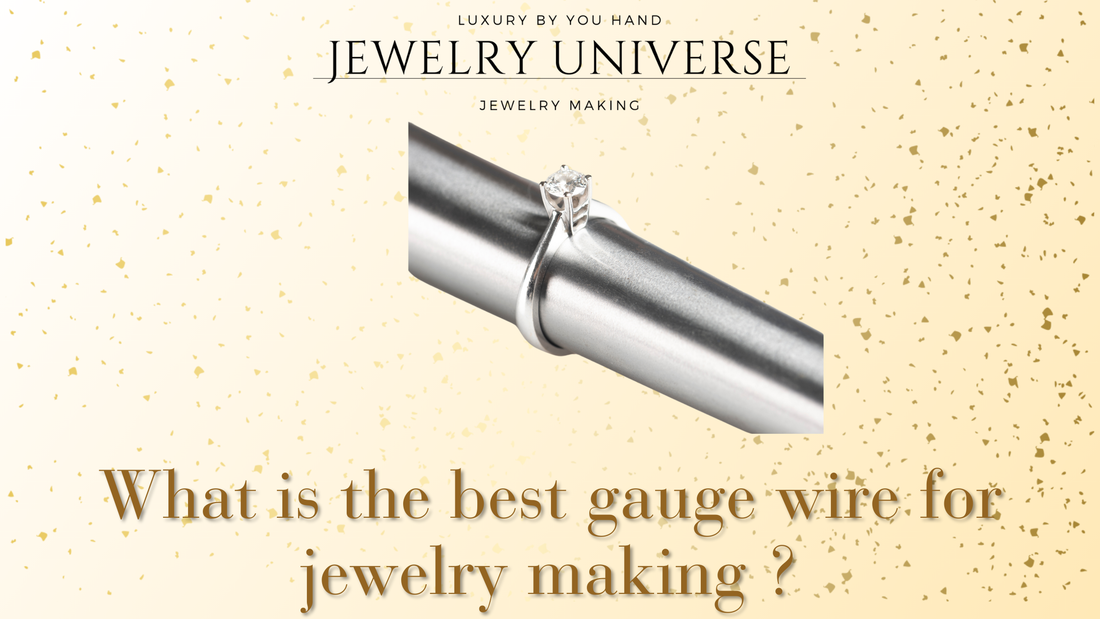
What is the best gauge wire for jewelry making ?
Share
When it comes to crafting beautiful and durable jewelry, the type of wire you use plays a pivotal role. The gauge of the wire is especially crucial as it determines the strength, flexibility, and overall aesthetic of your designs. In this article, we’ll dive into what is the best gauge wire for jewelry making, providing you with a detailed guide to help you choose the perfect wire for your creations.
Understanding Wire Gauge in Jewelry Making
What Does Wire Gauge Mean?
The term "wire gauge" refers to the thickness of the wire, measured using the American Wire Gauge (AWG) system:
- Higher numbers indicate thinner wire.
- Lower numbers indicate thicker wire.
For example, a 20-gauge wire is thicker than a 28-gauge wire.
Why is Wire Gauge Important?
The gauge affects the wire's:
- Durability: Thicker wires are stronger.
- Flexibility: Thinner wires are easier to bend.
- Use case: Different projects require different gauges.
Common Wire Gauges for Jewelry Making
16 to 18 Gauge
- Best for: Structural pieces like bangles and cuffs.
- Characteristics:
- Thick and sturdy.
- Hard to bend but holds shape well.
20 to 22 Gauge
- Best for: Jump rings, earrings, and lightweight necklaces.
- Characteristics:
- Versatile and easy to work with.
- Suitable for wrapping and bending.
24 to 28 Gauge
- Best for: Intricate wire wrapping and weaving.
- Characteristics:
- Thin and delicate.
- Great for detailed designs but less durable.
Choosing the Best Gauge Wire for Specific Jewelry Projects
For Rings
- Gauge recommendation: 16 to 18 gauge for the base; 20 to 22 gauge for wrapping.
- Why:
- Thick wire ensures durability.
- Thinner wire adds decorative detail.
For Earrings
- Gauge recommendation: 20 to 24 gauge.
- Why:
- Light enough to be comfortable.
- Strong enough to hold embellishments.
For Necklaces
- Gauge recommendation: 20 to 22 gauge for chains; 24 to 28 gauge for pendants.
- Why:
- Mid-range wire balances strength and flexibility.
For Wire Wrapping
- Gauge recommendation: 24 to 28 gauge.
- Why:
- Thin wire allows for intricate details.
- Flexible and easy to manipulate.
Factors to Consider When Choosing Wire Gauge
Material
- Copper and brass: Affordable and easy to shape.
- Sterling silver: Durable and hypoallergenic.
- Gold-filled: Luxurious and tarnish-resistant.
Jewelry Type
- Structural designs require thicker wire.
- Decorative and intricate designs work best with thinner wire.
Personal Skill Level
- Beginners: Start with 20-gauge wire as it’s versatile and easy to handle.
- Advanced: Experiment with a range of gauges for diverse projects.
Tips for Working with Different Wire Gauges
Handling Thick Wires (16–18 Gauge)
- Use strong pliers to cut and shape.
- File the ends to avoid sharp edges.
Manipulating Thin Wires (24–28 Gauge)
- Handle gently to prevent kinks.
- Use nylon-jaw pliers to straighten without damage.
General Tips
- Always test the wire’s flexibility before starting.
- Keep a variety of gauges on hand for different needs.
Advantages of Using the Right Gauge Wire
Durability
Choosing the correct gauge ensures your jewelry withstands wear and tear.
Aesthetic Appeal
The appropriate gauge complements your design and enhances its visual impact.
Ease of Crafting
Using the right gauge simplifies the crafting process and minimizes frustration.
Common Mistakes to Avoid
Using the Wrong Gauge
- Too thin: Leads to fragile designs.
- Too thick: Difficult to manipulate.
Skipping Material Testing
- Always check if the wire works well with your chosen beads and findings.
Ignoring Design Requirements
- Match the gauge to the specific demands of your project.
Tools to Work with Different Gauges
- Pliers: Flat-nose and round-nose for shaping.
- Cutters: Heavy-duty for thick wire, precision cutters for thin wire.
- Mandrels: For consistent shaping.
- Files: To smooth edges.
FAQs About Wire Gauge
What is the most versatile gauge for jewelry making?
- 20-gauge wire is the most versatile, suitable for a wide range of projects.
Can I use one gauge for all my jewelry?
- While possible, using multiple gauges enhances your designs and improves functionality.
How do I store my wire?
- Keep wires in spools or labeled bags to prevent tangling and confusion.
Summary of Wire Gauge Recommendations
Here’s a quick guide to help you choose:
- 16–18 Gauge: Structural pieces like bangles.
- 20–22 Gauge: General-purpose use, including earrings and necklaces.
- 24–28 Gauge: Fine detailing and wrapping.
Understanding what is the best gauge wire for jewelry making can transform your creations from simple to stunning. Whether you’re a beginner or an experienced crafter, selecting the right gauge ensures durability, flexibility, and a polished finish. Experiment with different wire gauges to discover the endless possibilities in jewelry design.
